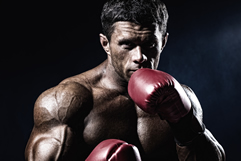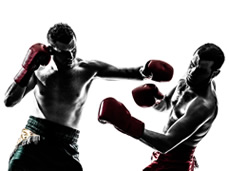
Sports Vision Training consists of the learning and training of Dynamic Visual Skills – that is ‘Vision in Motion’. These skills include Accommodation and Convergence, Anticipation Timing, Concentration under Stress, Depth Perception, Eye-Hand Coordination, Peripheral Awareness, Speed and Span of Recognition and Visual Reaction Speed. (For more in-depth explanations, see the attached Visual Skills definition sheet.) These are all learned skills that can improved with practice.
The following is an explanation of the most relative dynamic visual skills associated with boxing.

Since timing is the key to effective performance, knowing the right time to throw a punch is very crucial. It is also important not to over-commit yourself in response to an opponent’s feints.
It is essential to be able to focus through distraction and maintain a high level of concentration throughout the bout, not allowing crowd noise, flashing lights or an opponent’s taunting to be a distraction from the task at hand. A slight deficiency or lapse in concentration can mean mental or physical error, which could mean the loss of a bout – or worse – injury.
The ability to deliver an effective blow is much more complicated than it may appear to the casual observer. It involves a snapping and twisting motion that makes it necessary to determine the exact distance of an opponent in order to deliver the blow with maximum power.
Total coordination is essential to the maintenance of good balance. Fighters, therefore, have an obvious need to integrate a sense of balance with the visual motor system. Eye-Hand coordination is also one of the keys to landing effective punches within the scoring range.
Boxing is a very fatiguing sport, especially when both fighters are evenly matched in weight, skills, and conditioning. Professional bouts for championships can go fifteen three-minute rounds. With only a one-minute rest between rounds, physical fatigue is guaranteed. This drain of energy can greatly affect concentration, visual reaction time and eye-hand coordination. Eye fatigue can also affect performance levels in much the same way. When the muscles in our eyes feel tired or strained, we feel the fatigue all over. Just as we use weight lifting routines to improve physical endurance levels, we can also use a program of visual exercises to enhance your eye muscles, and thereby reduce fatigue.
Eye tracking ability is important for a boxer if he plans to hit a moving opponent who is not only bobbing and weaving in front of him, but around the ring as well. Quick, accurate saccades (or eye movements) are needed to center in on the moving target’s vulnerable areas.
This is helpful to a boxer on both defense and in his attack. Most boxers’ soft center in their opponent’s upper torso to chin area while being peripherally aware of both glove and body movement. When peripheral vision is reduced or hindered by a cut or mouse on the orbit of the eye, the boxer is in greater danger of further injury because he can’t see the blows coming (especially hooks) to defend against them. It is also imperative for the boxer to always know where he is in the ring relative to the ropes, the other boxer, and the referee, and he can’t take his eyes off the opponent to determine this, even for an instant.
The faster a boxer can discern a feint (fake) from a real incoming punch of a certain type (hook, jab, uppercut, etc.), the more time he has to parry the blow and even perhaps counterpunch.
The process of visualizing a specific opponent, or the particular style of an opponent (shadow-boxing), and visually rehearsing every type of punch, combination, and defense, can dramatically improve overall performance.